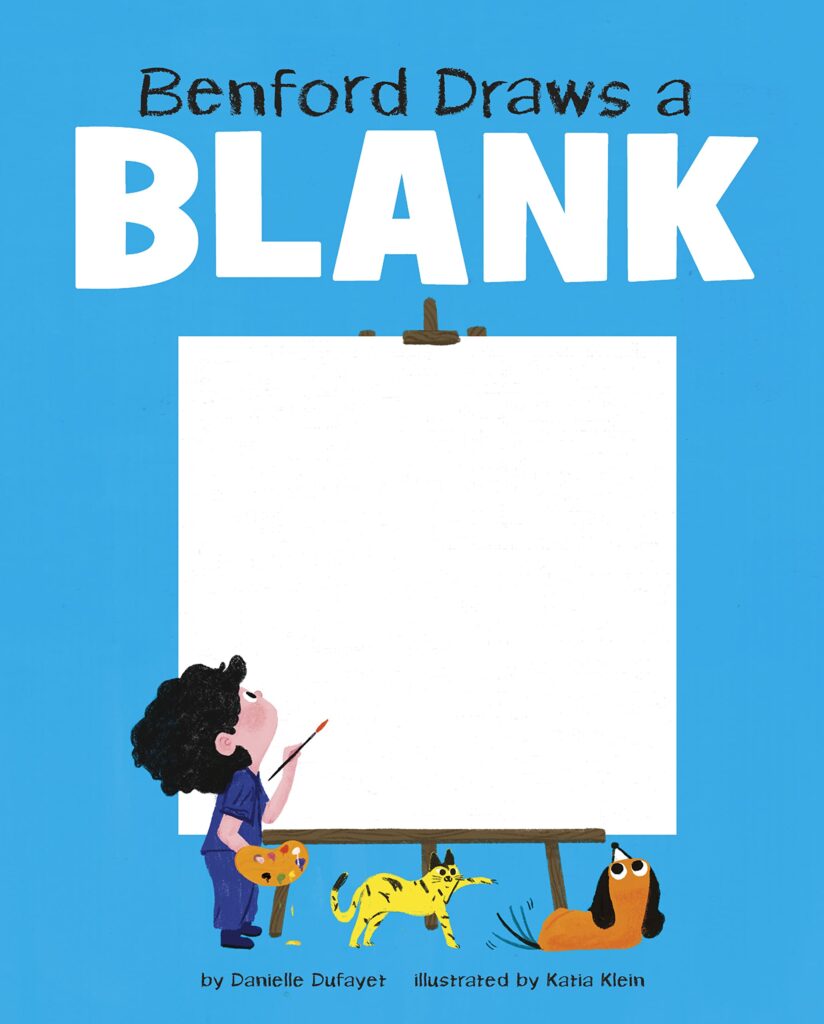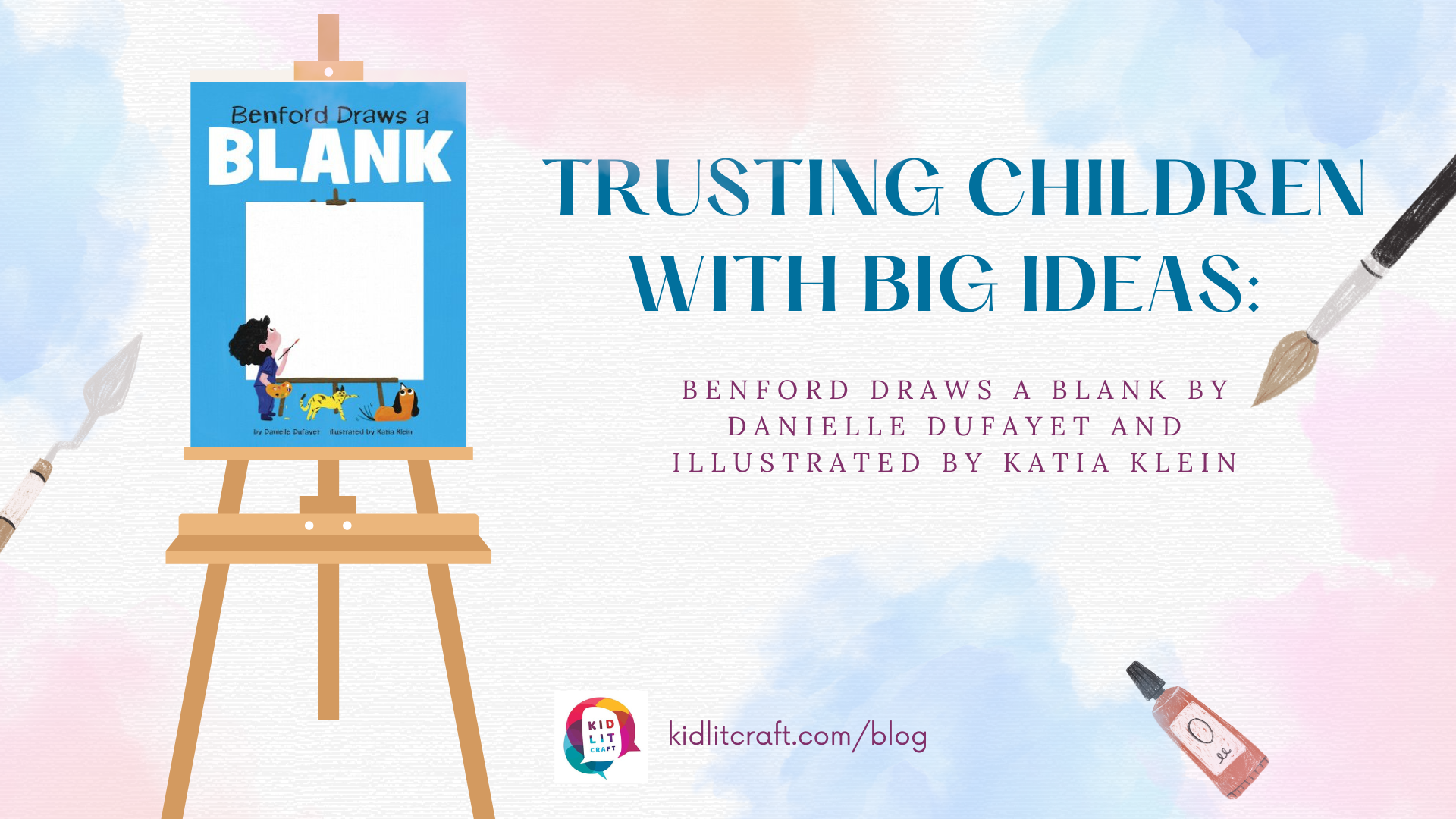by Kristi Wright
In Benford Draws a BLANK, author Danielle Dufayet and illustrator Katia Klein tackle the concept of being blocked as an artist. This may feel like a pretty advanced theme, more suited to adults than children. But there are very few topics that children can’t be trusted with, if handled the right way.
Benford is a child who loves to draw. When he receives a large, pristine white canvas for his birthday, he’s thrilled but also daunted. Suddenly, he worries that his artwork must be perfect. And his desire for perfection causes him to not only draw a complete blank when it comes to what to paint but also be haunted by the blank canvas. This haunting plays out anthropomorphically with a ghostly canvas who follows Benford around. He has to find his way back to feeling joy in creation and letting go of his need for perfection to finally stop being haunted and break his artistic block.

Let’s see how Dufayet and Klein make the powerful concept of being artistically blocked both fun for kids to read and easy to comprehend.
FINDING THE RELATIONSHIP BETWEEN THE TOPIC AND THE CHILD EXPERIENCE
Maybe most children don’t think about things like “artistic blocks,” but we’ve all seen them clam up in a classroom, afraid their thoughts or projects won’t be good enough. They hesitate before speaking or creating, looking to their friends for hints of what might be a valid response.
Not every child will be as precocious as Benford when it comes to art, but children do have to perform creatively at school. They can totally relate to a situation where fear stops a child from being able to perform the way they would like to.
CUTE ANIMALS BRING THE FUN WITHOUT WORDS
Let’s face it, cute animals make everything more fun. In almost every page of Benford Draws a Blank, an adorable cat and dog are up to shenanigans in the background (or foreground). The dog, Van Gogh, plays a starring role whereas the cat is more of a bit part. Not only does Van Gogh provide a lot of humor, he also plays an active role in the action, since Benford brings Van Gogh on his adventures when he walks away from his blank canvas to try to take his mind off the pressure he’s feeling to create the perfect work of art.
The animals are a source of comfort for Benford and also a huge inspiration. When he finally breaks through his artistic block, he even uses his cat and dog as art models. Many children will relate to finding comfort in pets and also being inspired by them in their own creative endeavors. Growing up, my daughter always included her real and imaginary pets in her art.
Most of the fun, cute pet storyline plays out in the illustrations rather than the words. However, as one of Dufayet’s critique partners, I know that she always saw Van Gogh the dog in his role as an inspiring, comforting sidekick. And she envisioned both animals, via brief art notes to the illustrator, as mechanisms for added humor. Klein did a fabulous job of taking the cute animals and running with them. Their expressions, poses, and silly antics make the story infinitely re-readable.
A GHOSTLY BLANK CANVAS THAT WILL NOT LEAVE BENFORD ALONE
In the story, Benford is haunted–literally–by his blank canvas. Benford’s increasingly anxious thoughts and actions (in the text) combine with a blank canvas that transforms (in the illustrations) from a static object into an anthropomorphic character. Dufayet and Klein turn Benford Draws a BLANK into a bit of a ghost story, where Benford isn’t just frustrated by his inability to create, but he’s seriously haunted by it.
One of my favorite scenes is right after Benford escapes the square canvas that will not leave him alone.
When Benford got home, he checked his easel. “Phew, just my imagination.”
The “joke” in the illustrations is that while the canvas is now as stiff as a statue, there’s sweat in its upper right hand corner, like the “whew” emoji. To reinforce the joke, Van Gogh is pointing in a very irked way to an abandoned skateboard that he knows he left behind in the garden. The only way the skateboard made it back into the house is if the anthropomorphic canvas, who’s clearly nervous about being caught, rode it home!
The story strikes a perfect balance between reality and fantasy to give children a safe and fun place to explore their deepest emotions.
AN ACHIEVABLE FINAL PAINTING THAT DOESN’T INTIMIDATE
[SPOILER ALERT] Benford Draws a BLANK ends with Benford finally putting brush to canvas and creating something both unexpected and just right. The cool thing about his final painting is that it’s not intimidating. While it’s clever and clearly inspired by real life, its style doesn’t try for realism or perfection.
Also, Dufayet’s pacing at the end allows for Klein to give Benford room to create, modify, add, and paint over. All this revision is such a great visual for readers. It shows kids that it’s okay to make changes to art. What a great and inspiring point to get across to children, without hitting them over the head with it. In the final painting there are smudges and blotches, and nothing has the proper perspective…and yet, the painting is, indeed, “just right.”

I’m not sure I’ve ever seen another picture book get across this idea of embracing “mistakes” so beautifully in story form. Note: the fabulous picture book Beautiful Oops! by Barney Saltzberg explores similar themes in a concept book format.
Children learn a valuable lesson about not giving into fear and being willing to experiment and enjoy the process through a fun, fantastical story. I have no doubt that Benford Draws a BLANK will inspire a variety of insightful comments from children–a story with a big idea that’s sure to lead to more big ideas.
NOW IT’S YOUR TURN
Are you working on a project with a big idea that might at first glance feel more suited to an adult audience? If so, consider the following:
- Look for the intersection between your grown-up theme and a child’s experience. What do they do regularly that might be analogous to what you want to explore in your picture book?
- Look for opportunities to make your story fun–animals are always a green field. Anthropomorphic characters can bring the fun too.
- Add a bit of fantasy to your story. Give children something imaginative for them to delight in.
- Don’t set up children for failure. If they are expected to perform, make sure they see that things don’t have to be perfect, that they can try again, or fix things.
Find the author on social media:
For further reading, here’s a post on choosing the right words that leave room for illustrations in picture books:
And for more thoughts on how to tackle big themes, here are a couple of posts addressing middle grade novels:
Kristi Wright (co-editor) writes picture books and middle grade novels. Her goal as a writer is to give children a sense of wonder, a hopefulness about humanity, and a belief in their future. She is represented by Kurestin Armada at Root Literary. She is an active volunteer for SCBWI and a 12 X 12 member. Find her at www.kristiwrightauthor.com and on Twitter @KristiWrite.


Thank you, Kristi, for featuring my book, Benford Draws a Blank. I’m hoping kids (and adults) will continue to enjoy the process of creating and hush that little self-critical voice we all have inside of us.